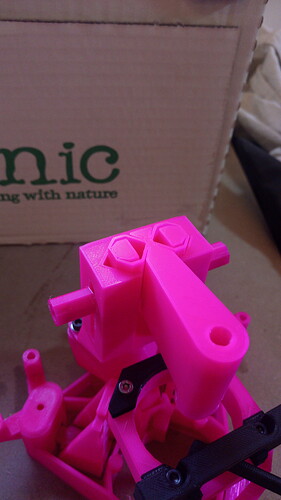My thinking on the optics/illumination mounting has evolved through a few versions. They have not yet been the same, so I’ll summarise for each below in case it’s helpful.
optics module
first version (v5.12 or something)
This used a smaller version of the dovetail that’s currently on the illumination. The optics module push-fit into the body. The “arms” were part of the body. This worked, and made it easy to assemble and coarse-adjust the focus. However, it went slack over time and if you abused it, you broke the main body.
I don’t think I ever swapped the dovetail round (so the breakable arms were on the optics module) but that might have solved one of the issues with it).
second version (later in the v5 series)
I swapped to using something similar to the current version, but with the concave part on the optics module. The slot didn’t have the “keyhole” opening, so the screw had to be inserted through the Z axis mechanism. This was really ropey! This coincided with the new Z axis design.
The bolted mount meant it didn’t go slack over time, and the shape self-centred and stayed aligned. Early versions had the “nose” of the convex part too pointy, so it didn’t self-centre properly and could wobble, later versions fixed that. Main disadvantage: it was a pig to assemble.
third version (same as v6)
I then made a few smaller changes:
- swapped the convex and concave parts, so the optics module was convex. This gave slightly more space for components in the optics module, and a slightly greater area in contact with the print bed at the base of the mount, on the main body side.
- used a “keyhole” shaped slot, so that the screw could be loosely inserted before the optics module was in place, then just tightened up in situ. This made assembly way easier.
My remaining gripes with the optics module mount are:
- access to the mounting screw is still a pain
- the keyhole slot has a limited Z adjustment range, so it’s not super customisable
- it can’t be slid slightly - it’s either locked or loose
illumination
The previous illumination was a wobbly monstrosity, and I won’t detail it much! Suffice to say it fitted onto the now-obsolete dovetail between the thin legs at the “front” of the microscope (opposite the Z adjuster) and was very, very, very wobbly.
The new illumination was pinched from a hacked-together inspection microscope, which is why it’s so chunky. It could definitely be narrower than it is and still work fine. I like that it feels solid but can still be adjusted (some folk will move it up and down more than others), but I would prefer it to be lockable with a screw.




